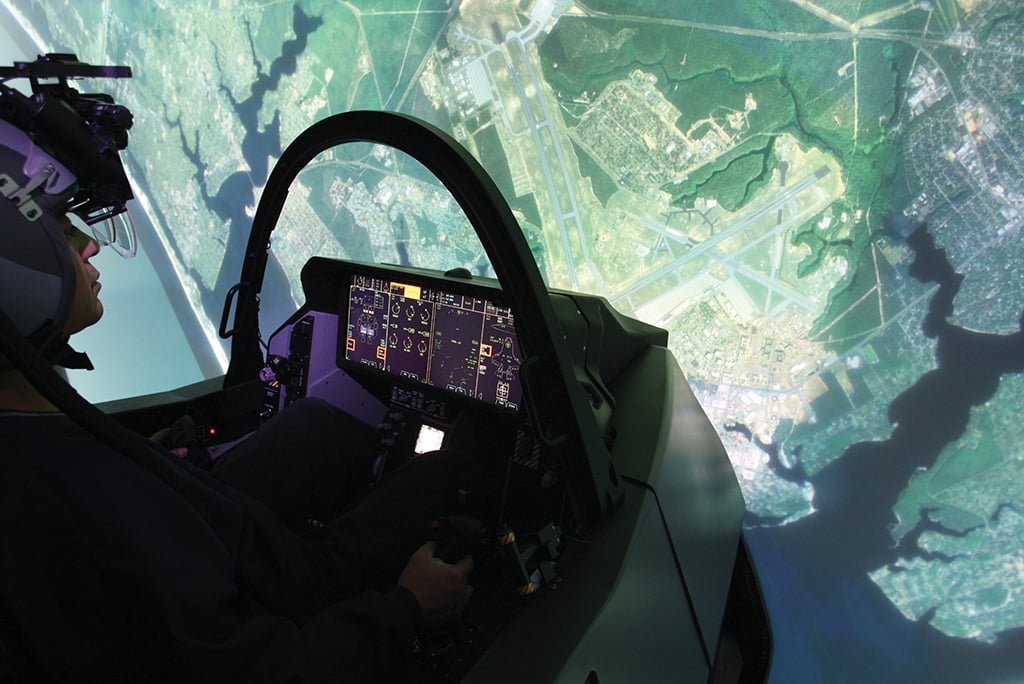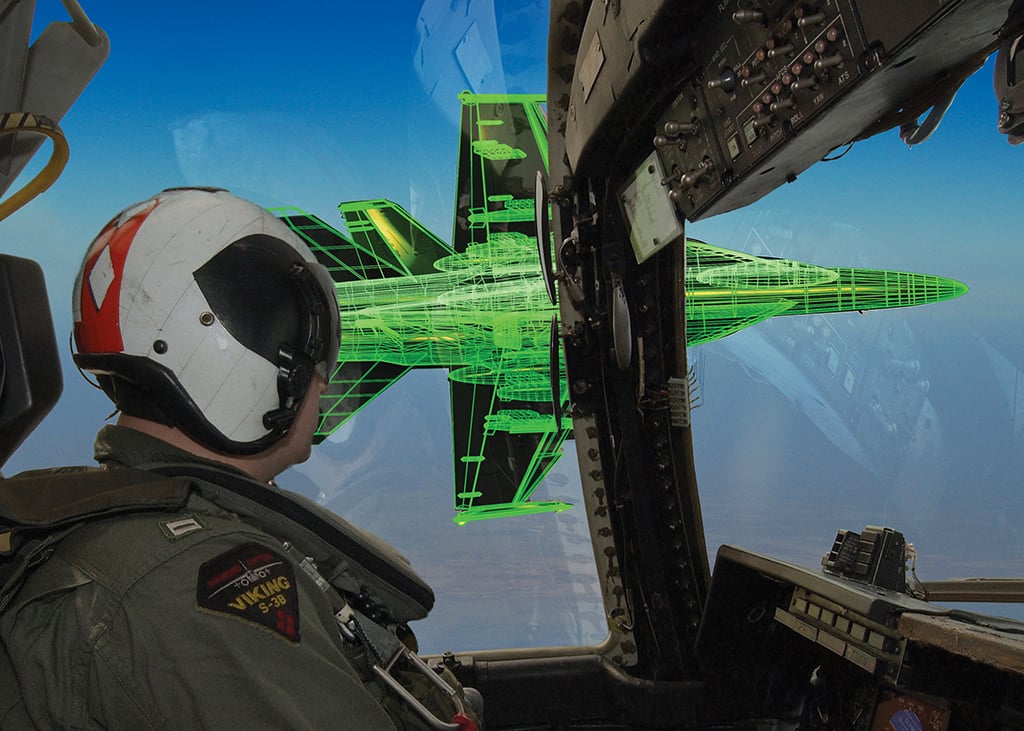
Air Force artwork shows a simulator cell in the Joint Simulation Environment.
At some point in August, operational testers will at last be able to put a Block 3F-equipped Lockheed Martin F-35 through a final gauntlet of the most complex air combat trials ever conceived for a modern fighter.
The Joint Simulation Environment (JSE), originally scheduled for 2017, is expected to host a series of 64 required test trials to complete the Initial Operational Test and Evaluation (IOT&E) phase, a mandatory step in the Pentagon’s acquisition process to clear a program to enter full-rate production.
- Opens door to a long-promised breakthrough in future air combat training
- Pentagon plans to make the environment a new standard in operational training
In the case of the F-35, the exercise might seem academic. Although technically still participating in an extended, five-year IOT&E phase, Lockheed Martin has delivered about 950 F-35s to 14 U.S. and international operators, 12 of which have declared the aircraft fit for combat.
But the long-delayed JSE-hosted test series will stress a soon-to-be-obsolete version of the F-35’s mission systems in a way that is impossible to replicate in open-air trials on test and training series.
The events also will open the door to a long-promised breakthrough in future air combat training beyond the operational test community, linking live and synthetic aircraft in real time to simulate scenarios with complexity, ranges and numbers that would be impossible within the limitations of open-air ranges.
At the same time, the factors that drove a six-year delay to begin IOT&E testing in the Defense Department’s JSE facilities also point to future challenges. To realize the JSE to its full potential for operational training, U.S. defense officials must address a gap between the need to integrate the software-based models of weapon systems developed by several companies and the way the defense industry traditionally views intellectual property ownership of those same digital models.
For example, the Block 3F software set for IOT&E testing is being replaced with early versions of Block 4 software in operational jets, with a Technology Refresh-4 hardware package scheduled to enter service next year that will enable further Block 4 software releases. But the Pentagon is still negotiating the software licenses needed to obtain the rights to integrate the digital model of Block 4-equipped F-35 capabilities into the JSE.
The ongoing talks pose no obstacle to starting IOT&E testing on Block 3F software but are a roadblock to elevating the JSE as a tool for operational training instead of only operational testing.
“There are no software licensing issues impacting the configuration of JSE supporting IOT&E runs for score” as those tests will count toward the F-35’s “score” for passing IOT&E, a spokesperson for the F-35 Joint Program Office (JPO) tells Aviation Week. “We are working with our industry partners on software rights and licensing for future configurations of the JSE. While negotiations are ongoing, we cannot comment any further.”

Disputes over intellectual property rights and software licensing contributed to the delays in preparing the JSE for the IOT&E F-35 test trials.
To run the trials, the JSE requires access to a high-fidelity simulation of the aircraft and its mission systems, which the program calls the “F-35 in a Box” (FIAB). This system replicates the exact software used by the F-35’s radar, electronic warfare system, imagery sensors and communications, navigation and identification system. The FIAB runs the mission systems and aerodynamic data from a real F-35 integrated core processor, which includes the sensor fusion algorithms the aircraft uses to identify targets that would not be detected by a single sensor.
As the dispute developed in 2017, Lockheed officials said certain portions of the FIAB software were developed exclusively at the company’s expense and could not be used by the military unless it paid licensing fees. The JPO argued that the government had fully funded the F-35’s software development, and the military should not pay twice for access to the FIAB.
In the end, the JPO and Lockheed settled the dispute and agreed to a licensing scheme to support the IOT&E tests. But operational testers found several major deficiencies in the FIAB software, which has taken a few years to resolve. Program officials still expect to complete all 64 tests—representing 42% of all mission scenarios evaluated during IOT&E—by the end of the fiscal year in September. However, Nickolas Guertin, the director for operational test and evaluation (DOTE), says the final report may not be ready until 90 days after the JSE trials have been completed.
A JSE facility at NAS Patuxent River—one of four such test and training centers opened or under construction by the Navy and Air Force— is scheduled to begin the simulated IOT&E tests in August. The trials include 11 defensive counter-air scenarios, 22 cruise missile defense events and 31 combined offensive counter-air/air interdiction/destruction of enemy air defense tests. All of the scenarios are being staged in a simulated environment that presents a density and complexity of defenses over a geographic area that is not possible in open-air ranges, according to the DOTE’s latest annual report.
The next step is to apply the resources of the JSE facilities to operational training with the F-35 and other aircraft. Last March, Gen. Charles Q. Brown, Jr., the Air Force’s chief of staff, directed that all “relevant legacy aircraft” and future aircraft programs make themselves compatible for training in the JSE.

Accordingly, the 412th Test Wing at Edwards AFB, California, formally opened a JSE facility, allowing companies to install four simulators each for the F-35 and Lockheed Martin F-22. The facility includes two additional bays for future programs, with the Northrop Grumman B-21 soon to enter flight testing and the Next-Generation Air Dominance program on track to enter development next year. Another JSE facility is being built at Nellis AFB, Nevada.
Finally, the Air Force announced plans in March to build the Joint Integrated Test and Training Center (JITTC) at Joint Base Elmendorf-Richardson, Alaska. When the facility opens in 2027, the JITTC should offer the first facility for Air Force, Navy and international pilots to fly integrated live and simulated missions together. The goal is to directly link live aircraft tracking data over the sprawling Joint Pacific-Alaska Range Complex with simulators inside the JITTC.
However, the intellectual property issues between government and industry must be resolved first. Questions over data rights for such a comprehensive and realistic simulation environment have lingered for years.
Any negotiations may need to go beyond licenses between aircraft prime contractors and the government. The simulators in the JSE and the JITTC will need accurate and up-to-date digital models of the aircraft, weapons and sensors. That requires the Air Force to obtain a license to use the intellectual property of the digital design for the aircraft and a missile. In addition, the digital model from the aircraft manufacturer has to be compatible with software for the model of the weapon, or vice versa.
A possible solution is emerging with the Air Force’s Simulator Common Architecture Requirements and Standards (SCARS) program, which is creating a government reference architecture. Ideally, the interfaces defined by the architecture will allow suppliers to create compatible digital models. The architecture is expected to be released with the Increment 3 version of SCARS this year or in 2024.





